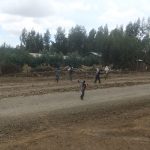This article analyzes how urban proximity introduces spatial heterogeneity in farm productivity within the high-value dairy sector in one of the poorest countries in Africa, Ethiopia. We look at how urban proximity—measured as travel time—affects the decisions and productivity of milk farmers located in rural production zones serving fresh milk to the capital Addis Ababa. Using an instrumental variable approach, we find that with each additional hour of travel time, farmers’ milk productivity per cow is reduced, on average, by almost 1 L per day or by 26%. When trying to disentangle the underlying mechanisms (and controlling for transaction costs), we find that farmers’ inclusion in “modern” value chains and their access to commercial milk buyers and milk processing companies drive the urban proximity effect. As only a limited number of farmers have access to such value chains in developing countries, measures to make dairy value chains more inclusive to remote—often poorer—farmers can, therefore, have important benefits for them, for the performance of the dairy sector in Ethiopia, and for the process of agricultural transformation as a whole. Read more.
